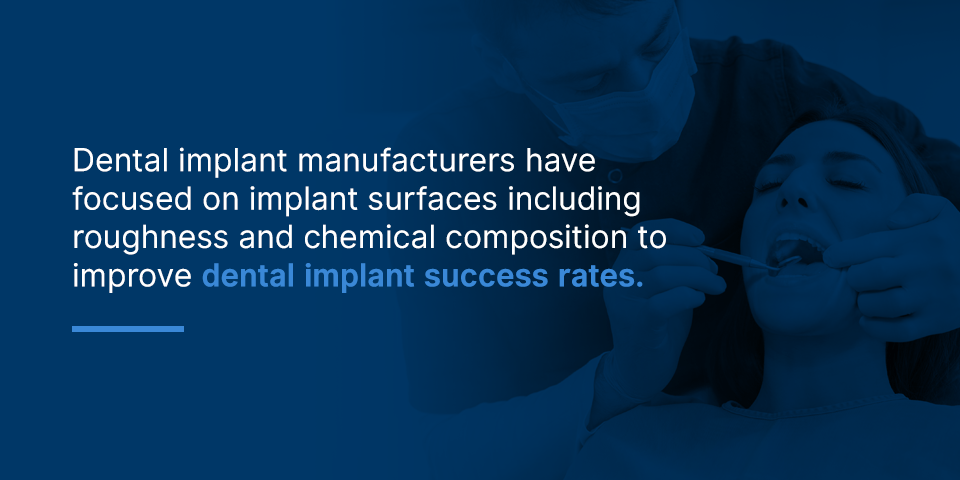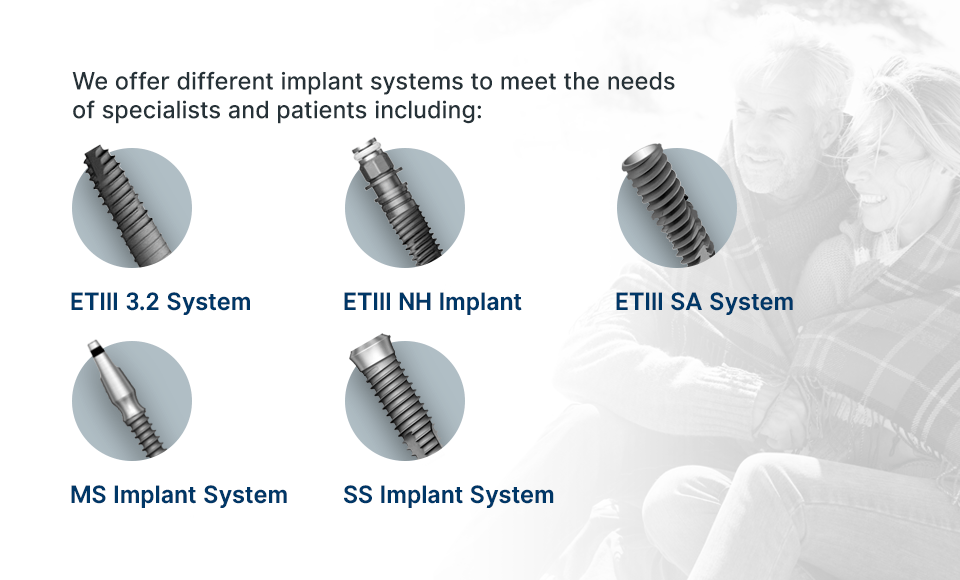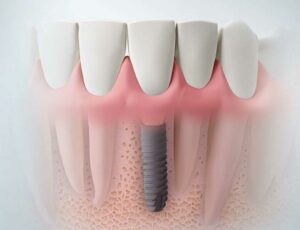Since the beginning of time, humans have been using some form of dental implants to replace missing teeth. In ancient Egypt, carved shells and bones were used as artificial teeth. In the 1930s in Honduras, archaeologists discovered dental implants dating back to about 600 A.D. that were made of shells.
The most important development in modern dental implantology took place in 1957 when Per-Ingvar Branemark, a Swedish orthopedic surgeon, discovered that titanium could successfully fuse with human bone. Branemark placed the first titanium dental implants in a patient in 1965. The implants lasted the patient’s lifetime. Now, about 450,000 dental implants are placed every year.
Patients and dentists prefer dental implants over other tooth replacement options for many reasons, including a high success rate. Nevertheless, there is plenty to learn about dental implants to determine if they are right for you.
Whether you are a patient considering dental implants or a dentist interested in offering dental implant treatment for your patients, this guide is for you. In this dental implants for dummies guide, we will explore the surgical aspect of dental implants as well as address common questions patients have about the dental implant process and the best types of dental implants available.
The Dental Implant Procedure

Tooth loss is widespread for many reasons ranging from gum disease to trauma. According to the American Association of Oral and Maxillofacial Surgeons (AAOMS), 69% of adults ages 35 to 44 have lost one or more permanent teeth. A dental implant is designed to replace a missing tooth and is composed of the following three parts:
- The dental implant, which is similar to a screw, is usually made of titanium and may be thought of as an artificial tooth root.
- The abutment is a small piece that attaches to the dental implant and functions as a connector.
- The crown is the custom-made artificial tooth that is attached to the abutment.
Dental implants are placed in the jawbone to form a stable base for the crown. Unlike dentures, dental implants help stop or prevent jawbone loss. Before a patient undergoes dental implant surgery, they typically complete the following steps:
- Initial consultation: First, a patient will meet with a general dentist. The dentist will usually take X-rays and examine the patient to determine if they are a good candidate for dental implants.
- Surgical evaluation: Next, the general dentist will refer the patient to a surgical specialist for a surgical assessment. The patient needs bone that is strong enough to handle a dental implant. If their jawbone is too soft, they may need a bone graft. During the surgical evaluation, the specialist will determine if a bone graft is required. A bone graft procedure involves adding special bone grafting material to create a strong foundation for the implants.
- Treatment planning: The surgical specialist develops the final treatment plan based on the patient’s needs and the surgical evaluation.

Depending on the patient’s condition, several procedures may be needed to create functional, natural-looking dental implants. These might include:
- Surgical extraction: A patient may need part of a tooth removed where the implant will be placed. After the removal of a tooth, a bone graft is usually placed to preserve the socket for the implant.
- Bone graft: When teeth are removed for any reason, bone reabsorption or deterioration occurs. As a result, some patients do not have sufficient jawbone to support an implant and require a bone graft. Grafting techniques either involve growing bone or replacing the bone, depending on the patient’s needs.
- Sinus lift: Sinuses are located behind the cheeks and on top of the upper teeth. Only a thin wall of bone separates the sinuses from the mouth when teeth are lost. When the sinus wall is very thin, a sinus lift procedure must be completed to make room for the implants. During this procedure, the wall is carefully lifted to create space for bone grafting material. Eventually, the new bone becomes part of the jaw and creates a space for dental implants.
When the patient’s jaw has adequate bone to support implants, they are ready for the procedure. Dental implant placement generally includes the following steps:
- The patient receives local anesthesia, so they do not feel any pain during the procedure.
- The dentist drills a hole to place the implant.
- The dental implant is placed into the bone socket using a special dental technique.
- Bone grafting material is usually placed around the implant to fill in the socket.
- The patient waits several weeks for the jawbone to heal and grow around the implant.
- Once the bone has formed, and the implant has healed, the final replacement tooth is attached.
Dental Implant FAQ
Patients usually have a lot of questions about the dental implant procedure and what to expect long term. Here are common concerns regarding dental implants and the recovery process.
1. How Long Does It Take to Recover From a Tooth Implant?

Recovery times vary between patients and depend on the procedures they need for success with dental implants. For example, if a patient requires a bone graft procedure, they will need to wait about two to three months for the bone graft to form new strong bone before continuing with the dental implant process.
Nevertheless, after the actual implant placement, many patients find they feel better faster than they expected. Some return to work the day after the procedure. Patients might experience bruising, swelling, slight bleeding and some discomfort as a result of dental surgery. Usually, over-the-counter pain medication is enough to help patients cope with post-surgery discomfort.
As the patient heals after the implant, they will undergo osseointegration, or the fusing of their jawbone with the implant. This process forms a solid foundation for their replacement teeth. Some patients might receive temporary teeth during this time. Osseointegration usually takes a few months. After osseointegration is complete, the specialist will place the abutment on top of the dental implant. Once the gums heal from the abutment placement, the specialist will place the custom-made crowns.
The entire dental implant process can take anywhere from three months to nine months depending on the patient and how many implants and procedures they need.
2. How Many Years Do Dental Implants Last?
Patients might ask if dental implants last forever. Dental implants are in fact designed to last a lifetime and have a success rate of 95% to 98% for periods of over 50 years. Dental implants have been found to last much longer than other tooth replacement options like dentures or dental bridges.
However, certain factors contribute to the success rate of implants. For example, patients who already practice good oral hygiene and keep regular dentist appointments improve their chances of long-term success.
3. How Much Does It Cost to Get a Full Mouth of Implants?
The cost of dental implants varies among patients and depends on different factors, such as how many appointments and procedures are needed to complete the process. Patients should keep in mind that although other tooth-replacement options may have lower costs up front, dental implants can last a lifetime, making them the most cost-effective choice in the long run.
According to the New York Times, implants for the full mouth or partial mouth typically cost from $20,000 to as much as $45,000. A specialist will calculate costs based on the time they spent to complete the procedure and materials used.
Patients with dental insurance might have some coverage for the procedure. However, dental plans typically have a maximum annual limit. Most plans only cover basic dental care and do not cover dental implants. Medical insurance may cover parts of the procedure, depending on the individual and their plan.
4. How Much Does a Dental Implant Cost for One Tooth?
A mentioned above, the exact dental implant kit cost may vary depending on the patient and the number of procedures needed. With that said, dental implant cost for a single tooth can be broken down in the following ways:
- Implant placement: $2,000 to $2,5000
- Bone graft if needed: $800 to $1,500
- Crown: $1,500 to $2,500
In total, the cost of a single dental implant can range from $4,300 to $6,500.
5. Can a Dental Implant Fall Out?

Although it is uncommon, a dental implant can fall out. This might occur due to any of the following reasons:
- An implant is placed before necessary healing times are complete.
- The dentist uses low-quality implants.
- An infection causes bone around the implant to weaken.
- An implant is placed without enough bone to support it.
- An implant is improperly placed.
Patients need to make sure they choose an implant specialist who is experienced and who uses only the highest-quality implant materials. If a patient notices the implant is loose after the healing period, they should contact their dentist right away. They may need to get the implant replaced.
6. What Are Problems With Dental Implants?
Patients might wonder what the dangers of dental implants are. However, if they go to a trained specialist, they should not have much to worry about. Problems with dental implants are rare, and when they occasionally occur, they are usually easy to treat. Smoking or other medical conditions increase the risk of issues. Problems include:
- Infection where the implant was placed
- Damage or injury to surrounding teeth, gums or bone
- Nerve damage, which might cause numbness in the lips, chin or gums
- Sinus issues when implants are placed in the upper jaw and enter a sinus cavity
One strategy implant clinicians may use to increase the predictability of dental implant treatment outcomes is a surgical guide. In general, a surgical guide is a digital dental surgery solution that’s created by taking precise imaging and impressions of the patient’s mouth to replicate the surfaces of the surgery site. The customized guide then assists the clinician in accurately drilling implants into the bone by providing sleeves to guide the implant and surgical instruments.
The first step to learning more about what a surgical guide for dental implants is can involve exploring the three main types: tooth-borne, mucosal-borne and bone-borne. Here are the main differences among these surgery guide techniques:
- Tooth-borne guides: This type of surgical guide is commonly used because it is easily adaptable and creates consistently reproducible marks that can provide stability, support and retention. Tooth-borne guides are most often used for single or multiple implants for fixed restorations.
- Mucosal-borne guides: Like the name implies, a mucosal-borne guide relies on the soft tissues inside the mouth for stability and support. Typically, this type of guide is fabricated based on a preexisting removable prosthesis. Differences in tissue quality and thickness may make this method less suited for certain patients.
- Bone-borne guides: For full-arch edentulous implant cases, a bone-borne guide is a go-to option. Because a bone-borne guide draws its support from naturally load-bearing areas, they can be difficult to fabricate. When created successfully, they are remarkably stable.
If an implant clinician decides to use a surgical guide, they will go over the design process and details during the treatment planning phase. Depending on the patient’s situation, a clinician may choose to freehand the implant placement, use a surgical guide or even stack multiple guides for accurate implant placement.
7. Why Are Dental Implants So Expensive?
Dental implants usually cost more than other forms of tooth replacement, but there are good reasons why dental implants are expensive. First, patients should consider that dental implants are an investment and designed to last a lifetime. Secondly, the dental implant procedure requires several steps before completion. When patients pay for dental implants, they are also paying for the following:
- Custom-made crowns
- Specialists, dentists, lab technicians and others involved in the process
- X-rays or 3D imaging
- Implant expertise
- Multiple appointments and procedures
- The use of special tools and materials to create results that last
Dental implant placement is an involved process, but the results are worth it. With high-quality, properly-placed dental implants, a patient will have a natural-looking smile and should not have to worry about replacing teeth in the future.
8. Who Is Best Qualified to Do Dental Implants?
A dental implant must be placed with a high level of precision, so it is vital for patients to choose a dentist with the skills and experience needed to perform implantation. Because dental implants are a surgical procedure, patients are advised to ask questions about experience and training before going to a general dentist for the procedure. Ideally, patients should go to a specialist such as an oral and maxillofacial surgeon or a periodontist.
9. What Are the Symptoms of Dental Implant Failure?

Traditionally, the success rate of dental implants has been high, but sometimes, dental implants fail. Certain factors, like smoking, increase the risk of dental implant failure. On rare occasions, the bone does not properly fuse with the implant. Other factors that could cause dental implant failure include:
- Infection
- Trauma
- Poor oral hygiene
- Quality and quantity of bone
- Specialist’s experience
- Implant quality
- Patient’s health
- Clenching and grinding teeth
- Head and neck radiation
Symptoms of dental implant failure might include:
- Wobbly or loose-feeling implants
- Pain or discomfort
- Difficulty biting or chewing
- Receding gums around the implant
- Gum inflammation
Dentists must ensure implants are stable from the beginning. Implants that do not have adequate initial stability have a failure rate of 32%.
10. Do Dental Implants Feel the Same as Natural Teeth?
Dental implants look, feel and function like natural teeth. They are the most effective option for a long-term natural smile. Unlike dentures, dental implants do not move around when patients eat or speak. Implants are customized to fit comfortably in a patient’s mouth and require the same care as natural teeth.
Dental Implant Options
If you’re wondering what is the best type of dental implant for you, let’s take a look at the most common options and the potential benefits of each:
Implant Method
There are two main types of dental implants, which include:
- Endosteal: Endosteal implants are usually made of titanium, shaped like a screw and placed directly in the jawbone. They are the most common type of dental implant.
- Subperiosteal: Subperiosteal implants are placed under the gum and on or above the jawbone. This type may be desired by patients who do not have adequate bone for dental implant placement and who also do not wish to undergo a bone graft procedure
Implant Configuration
Once you and your specialist have decided between those options, there are three different configurations in which dental implants can be implemented. Depending on your dental needs, you and your dental clinician can discuss which of these three types of dental implants would be best for you:
- Single implant: Your clinician can use a single implant to replace a single tooth.
- Implant-supported bridge: By putting two crowns at either end of a gap of adjacent missing teeth, your clinician can connect implants to replace several teeth.
- Implant-retained denture: If you need all your teeth replaced, an implant-retained denture will give you a permanent row of fake teeth that won’t slip out like traditional dentures.
Implant Material
In addition to implant method and configuration, it’s valuable to consider the best dental implant material for your situation. The material a dental implant is made out of is incredibly crucial because that material will be inside of your mouth permanently. For this reason, it is important to choose a dental implant made from a material that will not lead to health complications down the road.
Types of dental implant materials include titanium, titanium alloys, zirconium and gold. Titanium, including its alloy Ti-6 aluminum-4 vanadium, was the first modern material used for dental implants and remains the best dental implant material today. Compared to other materials, titanium has the longest lifespan to date. Commercially pure titanium is the preferred choice for dental implants because:
- It’s highly resistant to corrosion.
- It’s a light metal with good biocompatibility.
- It has a high level of stiffness.
Zirconia implants may prove effective in the future, but more research is needed before they would become the standard. Zirconia requires special consideration to reduce the chance of failure.
Other materials such as metal alloys composed of gold, stainless steel and cobalt chromium have been used in the past but have led to adverse reactions and low success rates. Therefore, these materials are considered outdated in the industry.
Other materials such as metal alloys composed of gold, stainless steel, and cobalt chromium have been used in the past but have led to adverse reactions and low success rates. Therefore, these materials are considered outdated in the industry.

Implants may be coated or sprayed with a variety of materials or molecules to promote cell attachment. This is because the physical and chemical characteristics of the implant surface are the most important factors in determining the speed and success of osseointegration. Dental implant manufacturers have focused on implant surfaces including roughness and chemical composition to improve dental implant success rates. Certain techniques, such as acid-etching, increase roughness and promote cell adhesion, greatly aiding the healing process and implant stability.
How to Find a Dental Implant Specialist

The dental implant procedure requires special training and knowledge. Although any dentist may legally perform dental implant surgery, it is highly recommended that patients choose a dental implant specialist. To locate a specialist, patients can follow these steps:
- Get a recommendation: A patient can speak with their general dentist for a recommendation. Patients should ask their dentist who they recommend as an oral and maxillofacial surgeon. They should also ask why they recommend the surgeon, what their specialties are, what their background is and if they would personally go to the recommended surgeon.
- Check insurance: A patient should see what their insurance covers first and look at the dental specialists listed in their insurance network.
- Research: Patients can use sources they trust to locate a specialist near them. They might search the directory on the American Dental Association (ADA) website or visit the American Academy of Implant Dentistry site and search for dental implant specialists.
Contact Hiossen® Implant for More Information
Hiossen® Implant is one of the top five dental implant companies in the world. At Hiossen, we are dedicated to developing high-quality, safe and innovative dental implants that clinicians and patients can trust. Our implants are the result of rigorous testing, research and expert recommendations. With a passion for providing superior dental implant solutions, we also provide research and education for dental specialists. Our goals include:
- Provide maximum aesthetic benefits
- Promote shorter healing and treatment periods
- Improve accuracy and convenience for specialists

We offer different implant systems to meet the needs of specialists and patients including:
- ETIII 3.2 System: A conventional solution for small diameters developed by our research team, our 3.2 models feature many characteristics of our award-winning ETIII SA implant such as an acid-etched (SA) surface for optimal roughness, an airtight seal to reduce micro-movement and bacteria exposure, apical design for initial stability, corkscrew thread and a biocompatible titanium build.
- ETIII NH Implant: Our ETIII NH Implant with a unique nano coating offers outstanding treatment outcomes and high success rates for patients, as well as shorter surgery times for specialists. The NH implant boosts healing time by 20% over implants with a resorbable blast media (RBM) surface.
- ETIII SA System: Our ETIII SA Implant is our award-winning implant that is the result of extensive research and testing. With a small thread for stability and path correction, an SA surface and hermetic seal, patients enjoy shorter healing times and high success rates.
- MS Implant System: Our MS System is a mini dental implant system and a cost-effective option specially designed for narrow spaces.
- SS Implant System: SS System Implants are designed for stability without bone grafts, even with soft jawbones. Their surfaces promote osseointegration and new bone growth, and they are designed for one-stage surgery procedures.
Hiossen Implant is committed to providing implants that make patients and dentists smile. We are proud to provide customer service and assistance that matches the quality of our products. To learn more information about our dental implants, specialized surgical kits, equipment or educational resources, contact us today!





